Advances in
eISSN: 2373-6402


Research Article Volume 3 Issue 5
Department of Agronomy, Ferdowsi University of Mashhad, Iran
Correspondence: Hessam Solouki, Department of Agronomy, Ferdowsi University of Mashhad, Iran, Tel +98-935-249-880-9
Received: May 06, 2016 | Published: May 12, 2016
Citation: Koocheki A, Mahallati MN, Solouki H, et al. Evaluation of radiation absorption and use efficiency in substitution intercropping of sesame (sesamum indicum L.) and mung bean (vigna radiata L.) . Adv Plants Agric Res. 2016;3(5):145-154. DOI: 10.15406/apar.2016.03.00109
An experiment was carried out as a split plot based on a randomized complete block design with three replications in 2013-2014 growing season. The main plots were five cropping systems, including: sole sesame, sole mung bean, intercropping (75% sesame-25% mung bean), intercropping (50% sesame-50% mung bean), intercropping (25% sesame-75% mung bean) and sub plots were two levels of weed control (weed-free and weedy). The results indicated that, radiation use efficiency of sesame throughout the growing season was variable from 0.461 to 1.199g.MJ-1 and in all cropping systems was higher than mung bean. Also, radiation use efficiency of mung bean was variable from 0.325 to 1.048g.MJ-1 and in all intercropping systems (weed-free and weedy) was higher than sole mung bean. The comparison among the different cropping systems revealed that, weed-free intercropping of 75% sesame-25% mung bean had the highest cumulative absorbed radiation, LERabs, LERdm and RUE, specially comparing to sole cropping system. Accordingly, the best recommendable system for intercropping of sesame and mung bean was weed-free intercropping of 75% sesame-25% mung bean. The comparison between weedy systems and weed-free systems also showed that, the amount of evaluated characteristics decreased with various weeds because of high competition and shared resources. Generally it seems that, enhancement of diversity and compatibility of plants with available resources, increasing the efficiency of resources and creating an eco-friendly complexity causes an increase in sustainability of agroecosystems.
Keywords: agro-ecological approaches, ecological sustainability, intercropping systems, radiation use efficiency, temporal diversity, absorbed radiation, LERabs, LERdm, mung bean, agroecosystems, leaf area index, light extinction coefficient, dry matter, land equivalent ratio
LAI, leaf area index; DM, dry matter; LER, land equivalent ratio; K, light extinction coefficient; RUE, radiation use efficiency
Sunlight is the main source of energy in agroecosystems. Light is absorbed by leaves and this energy is stored during the process of photosynthesis in chemical bonds of organic compounds and finally converts to the plant biomass. In order to increase the efficiency of this process is necessary to be aware of how changes in light absorption in plants. From an agricultural perspective, Understanding how light changes within the plant canopy is important within a farming system, Especially when considering various intercropping systems, agro forestry systems and even non-crop species management.1,2 Modern crop production systems attempt to optimize the sunlight utilization using the reliable and efficient crop management.3 Increasing agro-diversity is one of the best and most operational principles to optimize the sunlight utilization.4,5 Agro-diversity, a term of the 1990s, refers to interactions between agricultural management practices, farmers’ resource endowments, bio-physical resources, and species.6 Also, in another study pointed that, biodiversity refers to all species of plants, animals and micro-organisms existing and interacting within an ecosystem.7 Meanwhile, enhancing functional biodiversity is a key ecological strategy in agroecosystems if correctly assembled in time and space.8
A primary and direct way of increasing diversity in agroecosystems is intercropping system.9,10 Intercropping is a crop management system involving two or more crop species grown together for at least portion of their respective productive cycle and planted sufficiently close to each other so that inter-specific competitions occurs.11–13 The results of many studies revealed that, higher radiation absorption and use efficiency,14,15 water use efficiency,16,17 nutrient use efficiency,18,19 land use efficiency and yield advantages20,21 and reduction of weeds22 attained with intercropping. Intercrop yield is affected by solar radiation distribution in the intercropping canopy and intercrop RUE depends not only on crop canopy geometry but also on the intercropping arrangement. So, farmers must choose appropriate cultivars to best synchronies the crops.23
The results of an experiment indicated that, the productivity of intercropping, compared to monocultures, can be fully explained by an increase in accumulated light interception per unit cultivated area. The component crops are thus complementary in their interception of light over space and time.24 In an experiment also reported that, the increase in radiation productivity for maize (Zea mays L.)–soybean (Glycine max L.) intercropping compared with sole cropping was the result of an increase in radiation use efficiency and of a minor but significantly increase in radiation capture efficiency.25
The results of recent studies indicated that, intercropping system is one the efficient crop production managements with minimum adverse effects on the environment, using the principles of ecological agriculture. On the other hand based on the above facts it seems that, use of plant diversification is a useful approach to achieve sustainable agriculture and increase of resources use efficiency.26,27 Sesame (Sesamum indicum L.) is a member of the family Pedaliaceae and is an important oilseed crop with great commercial attributes by virtue of its oil, having an edible quality and medicinal value. It yields 50-60% oil and the oil is highly stable against rancidity due to the presence of the natural antioxidants sesamin and sesamolin.28,29 Also, mung bean (Vigna radiata L.) is an important summer annual legume crop and its seeds are a rich source of lysine and proteins.30,31 So, this research was arranged and accomplished to evaluate the radiation absorption and use efficiency in substitution intercropping of Sesame and mung bean in a low input system. Many scientific studies have been conducted in the context of intercropping and its beneficial advantages require further studies.
Experimental field
This study was carried out to evaluate the radiation absorption and use efficiency in substitution intercropping of sesame and mung bean during the growing season of 2013-2014 at the research farm of faculty of agriculture, Ferdowsi University of Mashhad, Iran, located on North latitude of 36˚, 15ʹ and East longitude of 59˚, 28ʹ with 985 m altitude above sea level. The experimental field was under organic fertilizers in the years before. Results of the physical and chemical properties of field soil are represented in Table 1.
Soil texture |
Total N (%) |
Available P (ppm) |
Available K (ppm) |
pH |
Organic matter (%) |
EC(dS.m-1) |
Loam- Silt |
0.081 |
10.9 |
162.52 |
8.44 |
0.88 |
1.1 |
Table 1 Physical and chemical properties of field soil (0-30 cm)
The experiment was arranged as a split plot based on a randomized complete block design with three replications. The main plots were five cropping systems, including: Sole sesame, Sole mung bean, intercropping (75% sesame-25% mung bean), intercropping (50% sesame-50% mung bean), intercropping (25% sesame-75% mung bean) and sub plots were two levels of weed control (weed-free and weedy). Plants were cultivated by hand, simultaneously. After planting, Irrigation was carried out immediately. The plant densities were 40 plants. m-2 for sole sesame and 20 plants.m-2 for sole mung bean and inter-row spacing was 0.5 m for both plants. The row ratios of intercropping systems were 1:1, 3:1 and 1:3 (substitution intercropping). Plants were irrigated every 6 days and weeds were controlled by hand during the days after sowing. In order to implement an ecological and low-input system, no chemical inputs were applied.
Experimental measurements
Leaf area index (LAI) and dry matter (DM): Plant samples were harvested every 15 days corresponding to 6 harvests during the vegetative stages (30, 45, 60, 75, 90, 105 DAS) by cutting plants just above the soil surface. Above ground dry matter was determined after oven drying at 70 ˚C for 48 h. Leaf area of sesame and mung bean were measured on the same harvests used for the measurement of above ground dry matter using a leaf area meter LI-3100C (Li-Cor biosciences, Lincoln, NE USA).
Radiation absorption and use efficiency: Simultaneous with measurements of LAI and DM samples, incident and transmitted radiation of the canopy were measured using a linear ceptometer, Sun Scan Canopy Analysis System (Accu PAR LP-80). Four measurements were taken above the canopy and four measurements were taken below the canopy by holding the ceptometer perpendicular to the rows at 10:30 am to 1 pm. Daily global radiation was estimated using method considering the daily sunny hours which were taken from the adjacent meteorology station.32
The light extinction coefficient (K) was determined from the slope of the linear regression between the natural logarithm of radiation transmission and leaf area index.33
Daily radiation absorption was calculated using Eq. (1-3).34,35
(1)
(2)
(3)
Where and are respectively, amount of radiation at above and absorbed by intercropping Canopy, Is and IM are amount of absorbed radiation by sesame and mung bean canopy, respectively. and are the light extinction coefficient of sesame and mung bean, respectively. Ls and LM are leaf area index of sesame and mung bean.
In each cropping system, radiation use efficiency (RUE) was estimated by the linear regression between cumulative amount of radiation absorption (MJ.m-2) and dry matter accumulation (g.m-2) (Figure 1).
Land equivalent ratio (LER)
The land equivalent ratio was calculated using Eq. (4 & 5).36
(4)
(5)
Where and are the yields of sesame and mung bean, respectively, as intercropping system and and are the yields of sole sesame and sole mung bean, respectively. and are the absorbed radiation of sesame and mung bean, respectively, as intercropping system and and are the absorbed radiation of sesame and mung bean, respectively, as sole cropping system. and are the land equivalent ratio for dry matter accumulation and cumulative absorbed radiation, respectively.
Statistical Analysis
Data statistical analysis and draw the figures were performed by statistical software Minitab, Ver. 16, MS Excel, Ver. 12 and Edraw Max Ver. 5. The means were also compared by using Duncan’s multiple range test at 5% probability level.
Leaf area index (LAI)
As it is shown in Figure 2 & 3, the results of evaluation trend of leaf area index (LAI) as affected by different cropping systems during the days after sowing showed that the plants grown in monoculture (100% sesame–0% mung bean and 0% sesame–100% mung bean) had the highest LAI (4.13 for sesame and 3.38 for mung bean) in comparison with other cropping systems. Also, the LAI of sesame in intercropping of 25% sesame–75% mung bean and LAI of mung bean in intercropping of 75% sesame–25% mung bean was at the lowest amount by 1.10 and 0.65, respectively. Since the leaf area index is equal to the ratio of leaf area to the ground area which leaves shade on that, certainly by increasing the number of plants per unit area, leaf area index also increases. So, the reduction of LAI may be due to the reduction of number of plants per unit area in substitution intercropping systems in comparison with monoculture system. Also, the results of comparison between weedy systems and weed-free systems showed that, the amount of LAI decreased with various weeds because of increasing competition and shared resources.

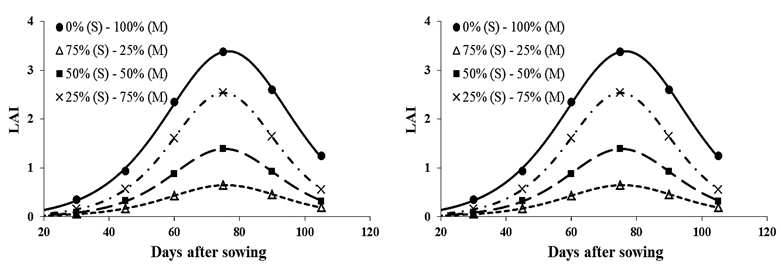
Light extinction coefficient (K)
According to the data points which were obtained from monoculture, the light extinction coefficient of sesame and mung bean was estimated 0.68 and 0.56, respectively (Figure 4). The scientists reported that, the most important effective factors on light extinction coefficient are including: environmental conditions, angle of the sun, angle of the leaves and leaf area.37 In another research also reported that, by reducing light extinction coefficient, light penetration into the canopy increases, so it may causes more radiation absorption by leaves.38 In relation to radiation use efficiency of peanut (Arachis hypogaea L.) reported that, by increasing of light extinction coefficient, radiation use efficiency decreased.39
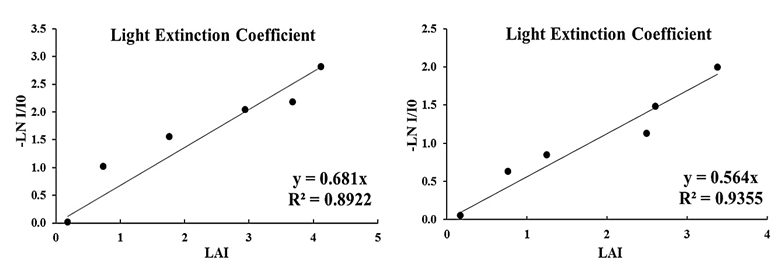
Radiation absorption
The results revealed that, weed-free intercropping of 75% sesame-25% mung bean had the highest amount of cumulative absorbed radiation (948.05 MJ.m-2) in comparison with other cropping systems (Table 2). It may be related to useful light distribution inside intercropping systems and more adaptation of intercropping canopy with available amount of light. Also it seems that, Plants in intercropping systems due to the different ecological niches, able to occupy all empty niches at least time and this point enhances the received light by intercropping canopy in comparison with sole cropping. The results of a study indicated that, the main benefit of intercropping in comparison with sole cropping is increase of absorbed radiation and efficient use of radiation per unit area.40
Treatment |
Cumulative Absorbed Radiation by Intercropping Canopy (MJ.M-2) |
Cumulative Absorbed Radiation by Sesame Canopy (MJ.M-2) |
Cumulative Absorbed Radiation by Mung Bean Canopy (MJ.M-2) |
LERabs |
Weed control system |
||||
Weed-free |
917.21 |
681.19 |
460.34 |
1a |
Weedy |
442.45 |
303.82 |
288.34 |
0.91b |
Cropping system |
||||
Monocrop of Sesame |
- |
709.85 |
- |
1a |
Monocrop of Mung bean |
- |
- |
718.03 |
1a |
(75% Sesame - 25% Mung bean) |
712.94 |
601.78 |
111.15 |
0.99a |
(50% Sesame - 50% Mung bean) |
673.66 |
439.7 |
233.96 |
0.92b |
(25% Sesame - 75% Mung bean) |
652.89 |
218.67 |
434.22 |
0.88b |
Weed control system × Cropping system |
||||
Monocrop of Sesame W1 |
- |
939.68 |
- |
1a |
Monocrop of Sesame W2 |
- |
480.03 |
- |
1a |
Monocrop of Mung bean W1 |
- |
- |
874.8 |
1a |
Monocrop of Mung bean W2 |
- |
- |
561.25 |
1a |
(75% Sesame - 25% Mung bean) W1 |
948.05 |
810.39 |
137.66 |
1.02a |
(75% Sesame - 25% Mung bean) W2 |
477.82 |
393.17 |
84.65 |
0.97a |
(50% Sesame - 50% Mung bean) W1 |
919.76 |
633.15 |
286.61 |
1a |
(50% Sesame - 50% Mung bean) W2 |
427.56 |
246.25 |
181.31 |
0.84ab |
(25% Sesame - 75% Mung bean) W1 |
883.81 |
341.53 |
542.28 |
0.98a |
(25% Sesame - 75% Mung bean) W2 |
421.97 |
95.81 |
326.16 |
0.78b |
Table 2 Cumulative absorbed Radiation (MJ.m-2) of Sesame and Mung bean in mono and intercropping systems
The results of evaluation trend of dry matter accumulation as affected by different cropping systems during the days after sowing showed that weed-free intercropping of 75% sesame-25% mung bean and weedy intercropping of 25% sesame-75% mung bean had the highest (1019.28 g.m-2) and the lowest (168.76 g.m-2) dry matter accumulation, respectively (Table 3). Weedy systems also indicated that, weeds had significant impacts on reduction of sesame and mung bean dry matter accumulation. On the one hand, by increasing proportion of mung bean in intercropping systems (50% sesame– 50% mung bean and 25% sesame-75% mung bean), amount of total dry matter decreased in the whole system (Figure 5 & 6). It may be related to less biomass production of mung bean in comparison with sesame.
Treatment |
Mean Dry Matter Accumulation of Intercropping (G.M-2) |
Mean Dry Matter Accumulation of Sesame (G.M-2) |
Mean Dry Matter Accumulation of Mung Bean (G.M-2) |
LERdm |
Weed control system |
||||
Weed-free |
852.37 |
683.16 |
167.54 |
1.09a |
Weedy |
202.76 |
152.42 |
47.19 |
1b |
Cropping system |
||||
Monocarp of Sesame |
- |
602.495 |
- |
1b |
Monocarp of Mung bean |
- |
- |
331.18 |
1b |
(75% Sesame - 25% Mung bean) |
629.19 |
544.77 |
84.57 |
1.15a |
(50% Sesame - 50% Mung bean) |
535.02 |
367.5 |
167.52 |
1.07b |
(25% Sesame - 75% Mung bean) |
418.34 |
156.39 |
261.95 |
1.01b |
Weed control system × Cropping system |
||||
Monocarp of Sesame W1 |
- |
977.46 |
- |
1bc |
Monocarp of Sesame W2 |
- |
227.53 |
- |
1bc |
Monocarp of Mung bean W1 |
- |
- |
490.72 |
1bc |
Monocarp of Mung bean W2 |
- |
- |
171.64 |
1bc |
(75% Sesame - 25% Mung bean) W1 |
1019.28 |
887.5 |
131.78 |
1.18a |
(75% Sesame - 25% Mung bean) W2 |
239.39 |
202.03 |
37.36 |
1.11ab |
(50% Sesame - 50% Mung bean) W1 |
869.92 |
608.2 |
261.72 |
1.16a |
(50% Sesame - 50% Mung bean) W2 |
200.12 |
126.8 |
73.32 |
0.98bc |
(25% Sesame - 75% Mung bean) W1 |
667.92 |
259.47 |
408.45 |
1.10ab |
(25% Sesame - 75% Mung bean) W2 |
168.76 |
53.32 |
115.44 |
0.91c |
Table 3 Dry matter accumulation (g.m-2) of Sesame and Mung bean in mono and intercropping systems
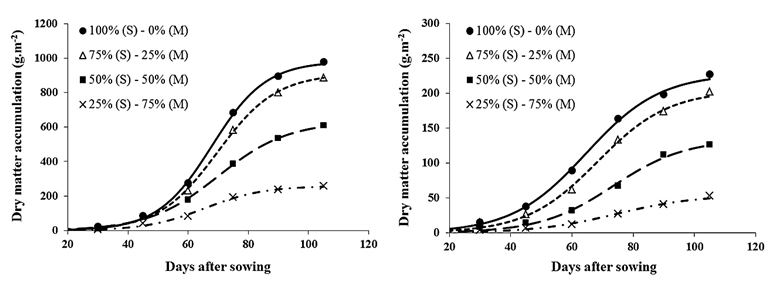
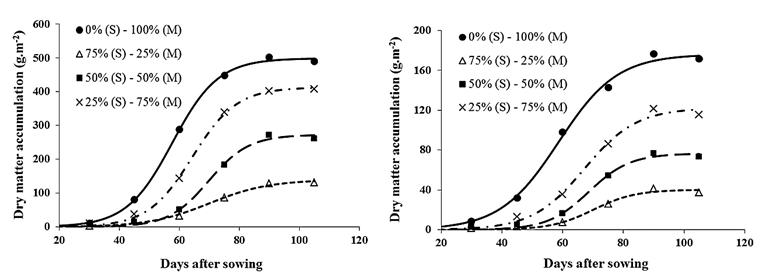
The result of an experiment in relation to intercropping of sesame and mung bean revealed that, the amount of sesame cumulative dry matter during the different growth stages increased in intercropping system.41 The results of a research indicated that, intercropping 50% sesame+50% beans had the highest yield and had no significant difference with monoculture of Sesame.42 In another study reported that, dry matter production in non-stress conditions is a function of time and the compilation of received photosynthetic active radiation, fraction of absorbed radiation and radiation use efficiency. Also, Harvest index as an important component of crops be added to the above factors.43
and
In order to evaluation of intercropping systems, different methods are used and the basis of these methods is always comparing intercropping system to sole cropping system. One of the most prevalent indices to describe the yield advantages is the land equivalent ratio that is related to efficiency of intercropping system and when LER is greater than one the intercropping favors the growth and yield of the intercropped species, whereas when LER is lower than one the intercropping negatively affects the growth and yield of the species.44 Accordingly, the land equivalent ratio was calculated for dry matter accumulation and cumulative absorbed radiation in this research (Table 2 & 3). The results showed that, the highest (1.18) and the lowest (0.91) was related to weed-free intercropping of 75% sesame-25% mung bean and weedy intercropping of 25% sesame-75% mung bean, respectively (Table 3). According to table 2, the highest (1.02) was related to weed-free intercropping of 75% sesame-25% mung bean. About the beneficial aspects of intercropping and increase of LER reported that, the superiority of this ecological concept depends on the choice of compatible plants to the minimum competition and the maximum association, application of appropriate crop management such as the plant density and mixing ratio.45,46
Study of substitution and additive intercropping of Sesame (Sesamum indicum L.) and Cannabis (Cannabis sativa L.) showed that, due to the shading of cannabis on sesame canopy and preventing the light absorption, the growth of sesame decreased. Despite this reduction, intercropping had positive effects on Cannabis and the most treatments had LER>1.47 In relation to competitive behaviors in intercropping of sesame and Peanut (Arachis hypogaea) reported that, intercropping of 66% sesame-33% peanut had the highest LER in comparison with other treatments.48 The results of another research about sesame intercropping with mung bean, peanut and sunflower (Helianthus annuus L.) also revealed that, sesame and peanut intercropping had the maximum LER.49
Radiation use efficiency (RUE)
The maximum radiation use efficiency (1.199g.MJ-1) obtained in weed-free intercropping of 75% sesame-25% mung bean (Figure 7). The results of sesame RUE in weedy intercropping systems also showed that, amount of RUE was improved in all intercropping systems in comparison with sole cropping system (Figure 8). RUE of Mung bean during the growth stages was variable from 0.608 to 1.048g.MJ-1 and 0.325 to 0.516 g.MJ-1 for weed-free intercropping systems and weedy intercropping systems, respectively (Figure 9 & 10). The mean comparison of sesame and mung bean RUE among the different weed-free intercropping systems indicated that, there was a significant effect between different cropping systems and RUE in intercropping of 75% sesame-25% mung bean was obviously higher than other cropping systems (Figure 11). Also according to Figure 12, RUE in all weedy intercropping systems was higher than sole cropping.
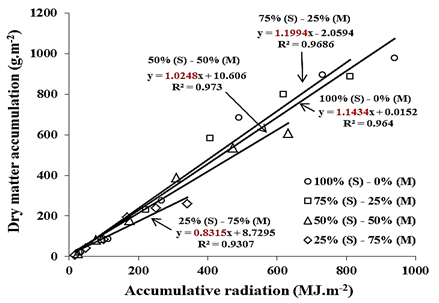


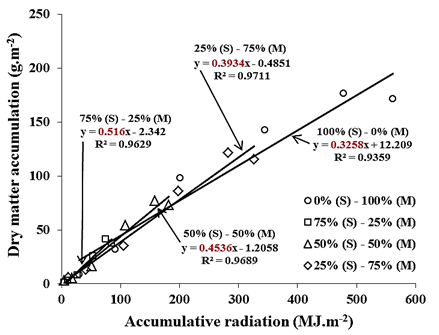
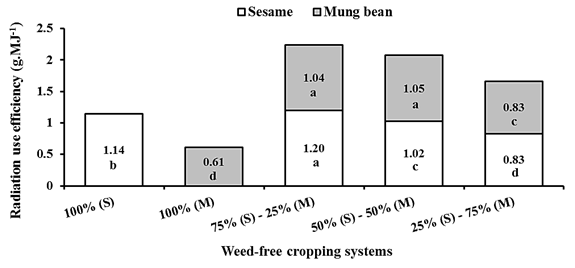
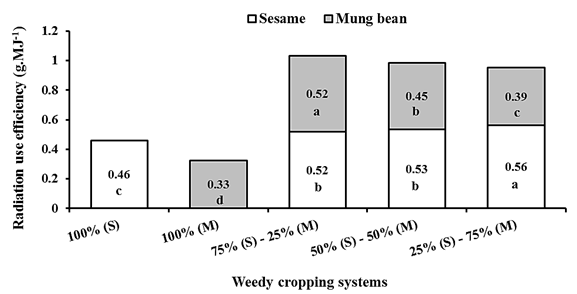
The result of this research was fully in agreement with those obtained by Tesfaye et al.50 They reported that, among the different C3 plants, non-legume species have higher RUE than legume species. Growth and yield of component crops in intercropping are depended on environmental resources availability and when other resources (e.g. water and nutrients) are not severely limiting crop growth, solar radiation is a major resource determining productivity of intercropping systems.51 Also, the high productivity of intercropping is often explained by processes above the soil surface, such as the light interception and radiation use efficiency.52
The result of a research in relation to evaluation of radiation use efficiency in sesame and chickpea (Cicer arietinum L.) revealed that, sesame RUE in all intercropping treatments was higher than sole sesame.53 In another study reported that, basil (Ocimum basilicum L.) and bean (Phaseolus vulgaris L.) intercropping caused an increase in RUE compered to sole cropping.54 The beneficial effects of intercropping on radiation use efficiency have been reported in many studies.55,56 Overall, the most significant advantage of intercropping is enhancing resources use and uptake efficiency, especially light. Of course, the use of these benefits requires an appropriate design and proper plants selection in intercropping systems.57
Plant dry matter production often shows a positive correlation with the amount of radiation intercepted by crops in both sole cropping and intercropping systems. On the other hand, dry matter accumulation is a multiplication of optimal level of absorbed radiation and radiation use efficiency. So, it can be concluded that, the possibility of increase in cumulative dry matter will be possible through improvement of radiation absorption and amplification of radiation use efficiency. The results of an experiment in relation to investigating of radiation use efficiency in intercropping of wheat (Triricum aestivum L.) and canola (Brassica napus L.) revealed that, radiation use efficiency in intercropping system was more than sole cropping system and increase of radiation use efficiency in intercropping treatments was due to the rapid closing of canopy and better cover of soil in intercropping system.58 Means of each bar followed by similar letters are not significantly different (Duncan 5%).
Results showed that, leaf area index decreased with various weeds because of increasing competition and shared resources (Figure 2 & 3). The light extinction coefficient of sesame and mung bean was estimated 0.68 and 0.56, respectively (Figure 4). Weed-free intercropping of 75% sesame-25% mung bean had the highest amount of cumulative absorbed radiation (Table 2). Weeds had significant impacts on reduction of sesame and mung bean dry matter accumulation and by increasing proportion of mung bean in intercropping systems, amount of total dry matter decreased in the whole system. The highest amount of and was related to weed-free intercropping of 75% sesame-25% mung bean by 1.18 and 1.02, respectively. Amount of sesame and mung bean RUE during the growth stages was variable from 0.461 to 1.199g.MJ-1 and 0.325 to 1.048g.MJ-1, respectively (Figure 7 & 8). Also, the maximum radiation use efficiency obtained in weed-free intercropping of 75% sesame-25% mung bean (Figure 7). As a general proposition can be noted that, we should design our behaviors based on the diversity conservation and these behaviors should be manifested in land use and the ways to achieve sustainable development. So, we should strive for protection of diversity as far as we can and be mindful that, every decision that we make, will have irreparable consequences for future generations.
None.
The author declares no conflict of interest.

©2016 Koocheki, et al. This is an open access article distributed under the terms of the, which permits unrestricted use, distribution, and build upon your work non-commercially.